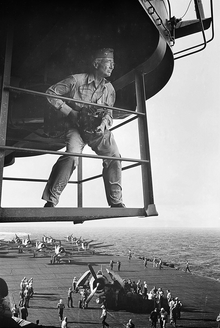|
Naval Aviation Photographic Unit
The Naval Aviation Photographic Unit[1]: 34 was a group of military photographers in the United States Navy during the Second World War, under the command of Edward Steichen. HistoryThe Navy had established this special group in early 1942, shortly after the US entry into the war, to document and publicize its aviation activities and allowed Steichen to recruit the most talented photographers he could find. Steichen and his unit initially reported to Capt Arthur W. Radford, and were made part of the Navy's Bureau of Aeronautics.[1]: 24 Because Steichen wanted an unusual amount of control over the unit, outside the purview of the Navy's pre-existing photographic community, and because Radford agreed with him, it was decided the unit would operate out of the Bureau of Aeronautics' Training Literature Division, which was under Radford's direct command.[1]: 34 This is why the unit's official name was "Training Literature Field Unit No. 1."[1]: 24 However, informally it was referred to as the Naval Aviation Photographic Unit, and is generally referred to that way in the literature about it.[1]: 24 [2][3]: 172 The main purpose Radford had for the unit was to promote the recruitment of pilots specifically for the Navy. Radford believed there was competition for a limited talent pool between the Navy and the Army Air Corps, and that attractive, top-rate photography in the press, posters, and leaflets would help the Navy reach its quota of 30,000 new pilots each year.[2]: 22 Wayne Miller, one of the unit's photographers, remembered Steichen's instructions this way: " 'I don't care what you do, Wayne, but bring back something that will please the brass a little bit, an aircraft carrier or somebody with all the braid; spend the rest of your time photographing the man.' It was Steichen's prime concern—don't photograph the war; photograph the man, the little guy; the struggle, the heartaches, plus the dreams of this guy. Photograph the sailor."[2]: 34 Radford was given command of Carrier Division 11 in July 1943.[1]: 103 Rear Admiral John S. McCain, Sr. was made head of the Bureau of Aeronautics, and thus Steichen's commander.[1]: 103 McCain was pleased by the results Steichen and his photographers were getting, and supported them fully, including seeing Steichen promoted to full Commander.[1]: 104 McCain also had Steichen do portraits of senior Navy officers, in the Vanity Fair style for which Steichen was known, to smooth relations for the unit among differing commands.[1]: 71 McCain's own portrait is shown below in the gallery. Steichen's responsibility increased to the point where, in early 1945, he was made director of a newly formed Naval Photographic Institute, and given formal control over all Navy combat photography.[2]: 49 The unit was largely demobilized after the end of the war in August 1945. As those servicemen with the most time overseas received priority in demobilization, almost all of the unit were home by Thanksgiving.[2]: 52 MembersThe group of photographers Steichen originally chose for the unit were:
Steichen wanted Ansel Adams to be part of the unit, to build and direct a state-of-the-art darkroom and laboratory in Washington, D.C.[3]: 172 In approximately February 1942, Steichen asked Adams to join.[3]: 172 Adams agreed, with two conditions: He wanted to be commissioned as an officer, and he also told Steichen he would not be available until July 1.[3]: 172 Steichen, who wanted the team assembled as quickly as possible, passed Adams by, and had his other photographers ready to go by early April.[3]: 173 Among the photographers whom Steichen later added in early 1945 was Morley Baer who remained with the unit until the end of the war. WorksThe photographs the unit produced were used as the basis for at least two contemporary books:
Gallery
References
|
||||||||||||||||||||||||||||||||||||||||||











